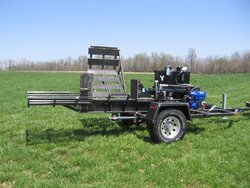I've been looking at several different hydraulic splitters. With info I've gathered from here and from other research, I've focused in on a 22 - 28 ton machine. I was hoping though that the experience and knowledge here can clear up a few questions for me.. One thing I've noticed is that even with the same advertised tonnage, there are a lot of variences such as hydraulic pump and engine size.
1. How does pump size affect performance? (example: splitter A has 13gpm pump, splitter B has 16gpm pump both are 28 ton and both have the same engine.) I thought a higher gpm pump would provide a faster cycle time but the advertised times are the same.
2. How much does engine displacement affect performance? I understand some brands of engines are more or less efficient than others but I've seen the same capacity splitter with two different size engines of the same brand. Given all other variables are equal, would a larger displacement engine offer any advantage over a smaller one?
3. I've noticed that most, if not all, splitters manufactured in the US have their splitting wedge "wrap" the beam. (I hope that makes sense! ) While overseas models seem to have their wedge ride in a "track". Are there any advantages/disadvantages to either design?
) While overseas models seem to have their wedge ride in a "track". Are there any advantages/disadvantages to either design?
4. When considering hydraulic splitters, are there any "must have" features? How about "steer clear of" features/designs/flaws? I know everyone will have their own personal preferences but I'd appreciate your input/experiences.
Thanks!
1. How does pump size affect performance? (example: splitter A has 13gpm pump, splitter B has 16gpm pump both are 28 ton and both have the same engine.) I thought a higher gpm pump would provide a faster cycle time but the advertised times are the same.
2. How much does engine displacement affect performance? I understand some brands of engines are more or less efficient than others but I've seen the same capacity splitter with two different size engines of the same brand. Given all other variables are equal, would a larger displacement engine offer any advantage over a smaller one?
3. I've noticed that most, if not all, splitters manufactured in the US have their splitting wedge "wrap" the beam. (I hope that makes sense!
 ) While overseas models seem to have their wedge ride in a "track". Are there any advantages/disadvantages to either design?
) While overseas models seem to have their wedge ride in a "track". Are there any advantages/disadvantages to either design? 4. When considering hydraulic splitters, are there any "must have" features? How about "steer clear of" features/designs/flaws? I know everyone will have their own personal preferences but I'd appreciate your input/experiences.
Thanks!


